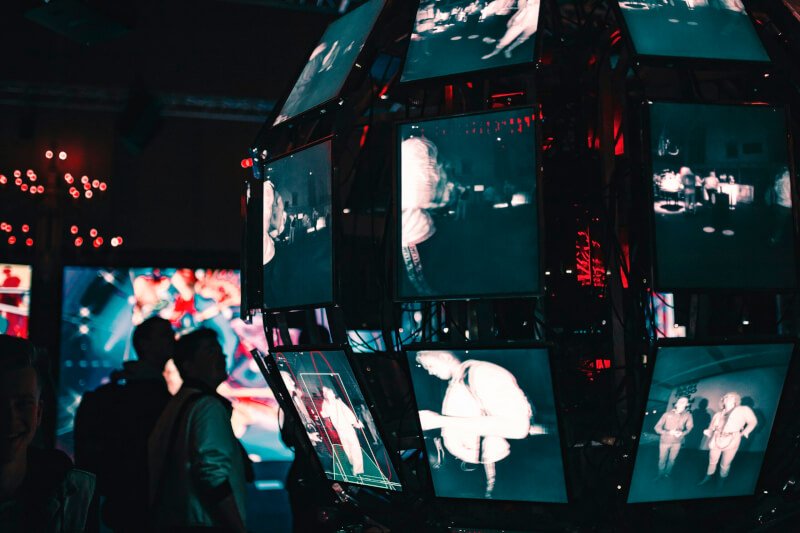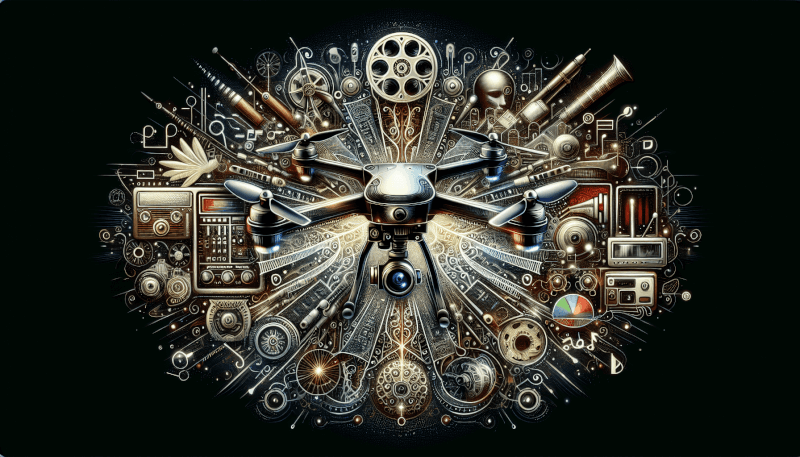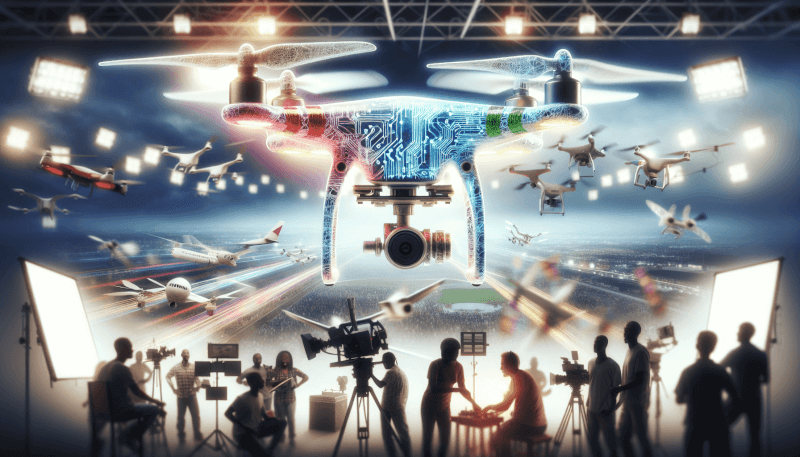Imagine a world where breathtaking aerial shots are no longer reserved for big-budget Hollywood films. Thanks to drone technology, this is now becoming a reality. Drones have revolutionized the way that the entertainment and media industries capture and showcase their content. With their ability to reach heights and angles that were once impossible, these unmanned aerial vehicles have opened up a whole new world of possibilities for filmmakers, photographers, and journalists alike. From stunning landscape shots to captivating live event coverage, drones are changing the way we experience entertainment and consume media. In this article, we will explore the impact of drone technology on these industries and how it is reshaping the way we view the world around us.
Cost-effective Filming and Photography
Drones have revolutionized the world of filming and photography by providing a cost-effective solution for capturing stunning aerial shots. In the past, aerial cinematography was an expensive endeavor that required the use of helicopters or cranes. However, with drones, filmmakers and photographers can now achieve high-quality aerial footage at a fraction of the cost.
By eliminating the need for expensive equipment and manpower, drones have made aerial photography and filming accessible to filmmakers and photographers of all budgets. Whether you are a professional filmmaker working on a big-budget production or an amateur photographer looking to enhance your portfolio, drones offer a cost-effective solution for capturing breathtaking aerial shots.
Capturing unique perspectives
Drones have the ability to capture unique perspectives that were once unattainable. With their compact size and maneuverability, drones can fly into tight spaces and capture shots from angles that were previously impossible. This opens up a world of creative possibilities for filmmakers and photographers, allowing them to capture shots that stand out and truly wow their audiences.
Imagine being able to capture a sweeping aerial shot of a breathtaking landscape or a bird’s-eye view of a busy city street. Drones allow filmmakers and photographers to get creative with their shots, adding a unique perspective to their work. Whether you want to capture the beauty of nature or the hustle and bustle of a metropolitan city, drones can help you capture stunning shots that will leave your audience in awe.

Enhancing visual quality
Thanks to advancements in drone technology, the visual quality of aerial footage has significantly improved. Drones are equipped with high-resolution cameras that can capture stunning images and videos with incredible detail. Whether you are shooting a film, capturing aerial photographs, or creating promotional videos, drones can help you achieve a level of visual quality that was once only achievable by professional cameras.
In addition to high-resolution cameras, drones also come equipped with stabilizers that minimize camera shake, resulting in smooth and stable footage. This eliminates the need for expensive camera stabilizers and allows filmmakers and photographers to capture professional-quality shots without the hassle of bulky equipment.
Improved Accessibility and Safety
Drones have made it easier than ever to access difficult terrains and remote locations. In the past, reaching remote locations for filming or photography purposes was a challenging and time-consuming endeavor. However, with drones, filmmakers and photographers can now access these locations with ease.
Whether you need to capture footage of a mountain range, a dense forest, or a vast desert, drones can help you get the shots you need without the hassle of navigating difficult terrains. Drones can fly over obstacles and reach places that are otherwise inaccessible, allowing filmmakers and photographers to capture unique and stunning footage.
Another significant advantage of using drones is the elimination of risks for human operators. In the past, aerial photography and filming often required human operators to work in dangerous conditions. From climbing tall structures to piloting helicopters, operators faced numerous risks. However, with drones, human operators can safely control the drone from the ground, eliminating the need for risky operations.

Providing access to remote locations
Drones have opened up a world of possibilities for media professionals by providing access to remote locations. Whether it’s capturing footage of wildlife in their natural habitats or documenting archaeological sites in remote areas, drones have made it possible to gather valuable visual content from locations that were once difficult to access.
By using drones, media professionals can now safely and efficiently gather visual content without disturbing the environment or disrupting wildlife. Drones allow for a non-intrusive way of capturing footage, providing a unique perspective that was previously unattainable.
Enhanced Live Event Coverage
Drones have transformed live event coverage by capturing dynamic angles in real-time. Whether it’s a sporting event, a music concert, or a public gathering, drones can provide unique and captivating footage that enhances audience engagement.
By flying drones above the crowd, media professionals can capture breathtaking shots that showcase the scale and energy of live events. From sweeping shots of the crowd to close-ups of performers, drones offer a perspective that immerses viewers in the event like never before. This enhanced visual experience not only captivates the audience but also provides alternative viewing experiences that make them feel like they are part of the action.
Furthermore, drones can be equipped with live streaming capabilities, allowing for real-time broadcasting of events. This opens up new possibilities for audience engagement, as viewers can watch live events from the comfort of their homes or on their mobile devices.

Efficient News Gathering
Drones have become a valuable tool for news organizations as they can quickly cover breaking news and monitor large areas. When a news story breaks, every minute counts, and drones offer a fast and efficient way to gather footage from the scene.
Instead of relying on helicopters or ground crews, news organizations can deploy drones to capture aerial footage of the incident in real-time. This allows journalists to gather accurate and up-to-date information without putting themselves at risk. Drones also provide a cost-effective solution for monitoring large areas, such as disaster-stricken regions or areas with ongoing conflicts.
In addition to their speed and efficiency, drones also minimize human interference during news gathering. Traditional methods of news coverage often involve intrusive camera crews and bulky equipment, which can be disruptive and intimidating. Drones, on the other hand, can operate from a distance without disturbing the scene or the people involved, ensuring a more objective and less intrusive approach to news gathering.
Advertising and Promotional Opportunities
Drones offer exciting opportunities for advertising and promotional videos by creating captivating visuals and targeting specific audiences. Whether you are promoting a product, a destination, or a brand, drones can help you create visually stunning commercials that capture the attention of your target audience.
With their ability to capture unique perspectives and dynamic shots, drones can help create visually striking commercials that stand out among traditional advertising methods. By using drones, advertisers can showcase their products or services from angles that were once only achievable by high-budget productions.
Furthermore, drones allow for precise targeting of specific audiences. By capturing footage from the air, advertisers can showcase the scale and unique features of their products or services, appealing to the interests and preferences of their target audience. This targeted approach enhances the effectiveness of promotional videos and increases the chances of reaching potential customers.

Augmented Reality and Virtual Reality Experiences
Drones have the potential to enhance augmented reality (AR) and virtual reality (VR) experiences by capturing immersive footage and combining it with virtual content. Whether it’s creating virtual tours, enhancing AR gaming experiences, or providing a combination of drone footage with VR content, drones can take AR and VR experiences to the next level.
By capturing aerial footage with drones, media professionals can create immersive virtual tours of destinations, allowing viewers to explore places from a unique perspective. This provides a more engaging and interactive experience for users, making them feel like they are actually there.
Drones can also be used to enhance AR gaming experiences by capturing footage from the air and combining it with virtual elements. This creates a more realistic and immersive gaming experience, where players can interact with virtual objects in real-world environments.
Furthermore, drones can capture footage that can be combined with VR content, creating a seamless integration of real and virtual worlds. Whether it’s capturing aerial shots for VR movies or combining drone footage with virtual elements in artistic projects, drones offer endless possibilities for creating innovative and captivating AR and VR experiences.
Innovative Cinematography and Visual Effects
Drones have revolutionized cinematography and visual effects by providing a new tool for achieving dynamic shots, enhancing action sequences, and adding realistic computer-generated elements. With their agility and maneuverability, drones offer filmmakers new creative opportunities that were once limited to expensive equipment and specialized crews.
Filmmakers can now achieve dynamic shots and movements that were previously only possible with the use of cranes, helicopters, or specialized camera rigs. From sweeping aerial shots to tracking shots through tight spaces, drones allow filmmakers to capture shots that add depth and energy to their films.
Drones are also valuable tools for enhancing action sequences. By capturing aerial shots of the action, filmmakers can provide a unique perspective that adds excitement and intensity to the scene. Drones can follow fast-moving objects, such as cars or athletes, and capture footage that immerses the audience in the action.
Furthermore, drones can be used to add realistic computer-generated (CG) elements to films. By combining drone footage with CG elements, filmmakers can create seamless visual effects that enhance the storytelling and visuals of their films. Whether it’s adding digital characters to real-world environments or creating realistic CG environments, drones offer a versatile tool for visual effects artists.

Challenges and Privacy Concerns
While drones offer numerous benefits, they also present challenges and privacy concerns that need to be addressed. Regulatory limitations and restrictions can hinder the use of drones in certain areas or for specific purposes. The airspace is heavily regulated, and drone operators must adhere to strict rules and regulations to ensure safety and prevent accidents.
Privacy is another major concern associated with the use of drones. As drones can capture footage from the air, there is a potential for invasion of privacy if not used responsibly. Protecting individuals’ privacy rights and ensuring that drones are not used for surveillance purposes without proper consent is crucial. Stricter regulations and guidelines are necessary to ensure that drones are used in a responsible and ethical manner.
Additionally, public perception of drones can also impact their usage. Some individuals may view drones as intrusive or a threat to privacy, leading to resistance or negative sentiments towards their use. Educating the public about the benefits and responsible use of drones can help alleviate concerns and foster a positive perception of this technology.
Lastly, security and safety precautions must be taken into consideration when using drones. As drones become more advanced and capable, there is a risk of unauthorized drone flights in restricted areas or potential safety hazards if not operated correctly. Implementing security measures and ensuring proper training and licensing for drone operators can help mitigate these risks.
Environmental Benefits
Drones offer environmental benefits by reducing the carbon footprint, monitoring wildlife populations, and assisting in conservation efforts. Unlike traditional aerial photography methods that required helicopters or planes, drones have a significantly lower carbon footprint as they operate using electric power.
By using drones instead of manned aircraft for aerial photography and filming, the carbon emissions associated with these activities can be drastically reduced. This contributes to a more sustainable and eco-friendly approach to media production.
Drones also have the potential to play a crucial role in the monitoring of wildlife populations. By capturing aerial footage, drones can provide valuable data on habitats, population sizes, and migration patterns. This information is vital for conservation efforts and can help researchers and conservationists make informed decisions regarding wildlife protection and management.
Furthermore, drones can be used to assist in conservation efforts by monitoring protected areas, detecting illegal activities such as poaching or deforestation, and providing valuable data for ecosystem management. This technology allows for more efficient and effective conservation strategies, ultimately leading to the preservation of our natural environment.
Future Possibilities and Advancements
The future of drone technology in the entertainment and media industries is promising, with several possibilities for advancements and integration with other emerging technologies. One exciting possibility is drone swarm performances, where multiple drones are synchronized to create stunning aerial displays. This can revolutionize live entertainment, creating captivating visual experiences that were once unimaginable.
Another area of advancement is the integration of artificial intelligence (AI) and automation with drone technology. By leveraging AI algorithms, drones can operate autonomously, making them more efficient and reliable. This can lead to increased capabilities for tasks such as real-time object tracking, precision navigation, and collision avoidance.
Furthermore, drones can integrate with other emerging technologies such as virtual reality (VR) and augmented reality (AR). By combining drone footage with VR or AR elements, immersive experiences can be created that blur the line between the real and virtual worlds. This opens up new possibilities for storytelling, gaming, and interactive experiences.
In conclusion, drone technology has had a significant impact on the entertainment and media industries. From cost-effective filming and photography to enhanced live event coverage and innovative cinematography, drones have revolutionized the way media professionals capture and present visual content. While challenges and privacy concerns exist, the benefits of drones, such as improved accessibility, environmental benefits, and future advancements, make them a valuable tool for the entertainment and media industries. As technology continues to evolve, it will be exciting to see how drones shape the future of entertainment and media.


